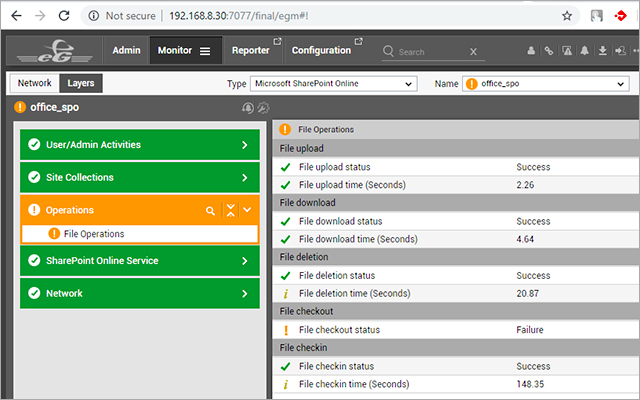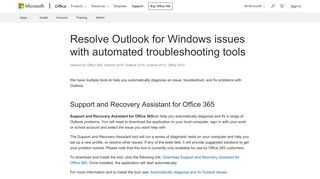How to Fix Outlook and Office 365 problems with Microsoft Support and Recovery Assistant App for Office 365Download Support and Recovery Assistant Tool: htt. The support & recovery Assistant for Office 365 covers a lot of ground and is used for general Outlook/Office troubleshooting, not as much focused on networking or connectivity issues. The tool is delivered via Click-to-Run and provides a step-by-step wizard for solving common issues for users of Office 365. This series is intended to provide you with technical support insights and proactive guidance for Office 365. We focus on support trends and issues which reflect customer needs. If you need individual technical support for a specific scenario, please log a service request in the online portal. A new Microsoft Support and Recovery Assistant for Office 365 is available. It's a troubleshooting tool for Outlook clients that will verify the credentials of end users, check the client's update.
Out in the field we are often called upon to troubleshoot issues with Office 365, this can range from incorrectly configured devices to connectivity issues to heaping users who want to understand if their PC is ready to be used with the latest wave. Microsoft has recently (well back in September) provided some new tools which help with Office 365 troubleshooting. This blog post introduces the new tools, I will post some walkthroughs on how best to use these over the coming weeks.

When you sign into the Office 365 portal you will now see a new menu item on the left for Tools. Below is a screen shot of the Tools that Microsoft has provided to help with analysing and troubleshooting. The screen shot below shows what’s available to you.
To introduce some of the more useful troubleshooting tools here is a brief description of how we’ve use some of these tools;
We often come across users who wish to use their existing PC to connect to an Office 365 service. If the customer in question has a plan which excludes Office 2010/2013 they often use their existing Office product to connect to Exchange and SharePoint Online. We get called when then can’t connect or access the service as expected. A quick check of the PC with the Office 365 Best Practices Analyzer tool often highlights a missing update or Office 365 Pre-Requisite component which is not installed.
There are also some very useful troubleshooting tools available https://testconnectivity.microsoft.com there is a section dedicated to Office 365 which allow you to perform a number of service wide tests from your browser. These can be useful in a variety of situations especially during a migration or shortly after when you need to test DNS records have been added correctly. Microsoft has recently updated this tool with new features, which can be used to help in identifying common connectivity issues for Outlook, Lync, and Office 365. screen shot of the tool is shown below which illustrates the tests available to you. The tool can be accessed from the client tab;
Finally if you have ever had to analyse message headers to determine the origins of a message and how it made its way through one or more SMTP servers to its destination then you will now that this can be a painful experience. Fortunately help is at hand, Message Analyzer, again apart of the Remote Connectivity Analyzer tools makes reading email headers less painful.
This post should help point you in the direction of some easy to use tools which can be used as the first steps in troubleshooting Office 365 issues. The next post in this series will provide some walk throughs in using these tools, starting with Message Header Analysis.
Until next time…….
Launched in 2011, Office 365 has made quite a reputation for itself as the go-to cloud productivity suite for businesses. With several subscription plans, flexible pricing, and a plethora of features that allow users to collaborate, communicate, and access their important documents as a team, Office 365 is a must-have for organizations that need to boost productivity and maintain efficiency. But as with all software, you may occasionally run into problems. In 2018, a number of users took to online forums to highlight a few Office 365 issues that can come during sign-in and activation . While Microsoft has mostly fixed these, users may still face some sign-in, account recovery, and activation issues.
Still having problems? Here’s a list of the most common Office 365 issues and their solutions.
Are you managing multiple Office 365 tenants? If yes, read our guide, 15 Tricks to Succeed in Managing Multiple Office 365 Tenants to help you save time. Click here to learn how.
User Error (Wrong ID or Password)
When trying to sign in to your Office 365 portal, you may have encountered the following pop-up message:
“We are unable to recognize this user ID or password.”
This usually occurs when a user accidentally enters the wrong login credentials. And there are two main causes: either you entered the wrong password, or you entered an incorrect ID (or both).
There are multiple ways to solve this problem. You can use either of the following two solutions depending on which one works best for your situation:
1. Incorrect User ID or Password
Check Your ID
Ensure that the correct user ID is entered and that you’re signing in using the email provided to you by your organization. Such email addresses generally look like someone@example.com or someone@example.onmicrosoft.com. Reason 10.2 patch keygen. If you’re unsure about the ID that was assigned to you by your organization, be sure to contact your administrator.

Check Your Password


Sometimes, employees save their passwords on their laptops or desktops and then copy-paste the data into sign-in fields. But this can sometimes cause problems. If you’re copying the password from somewhere else, make sure that you’re aware of possible unintentional spaces at the beginning or end of the password. Also, bear in mind that some passwords are case sensitive, so make sure every letter is correct.
2. Forgotten User ID or Password
If you can’t remember your ID or password, you can attempt to reset your own password through the self-service Password Reset wizard:
- If you’re using a work or school account, visit: https://passwordreset.microsoftonline.com.
- If you’re signing in from a Microsoft account, visit: https://account.live.com/ResetPassword.aspx.
- If you’re the administrator, you can attempt to reset your own password if you’ve already set up an alternate email address and a mobile phone number.
- If your organization has multiple Office365 administrators, ask another administrator to reset your password for you.
Note: If your account administrator has enabled the option that allows you to reset your own password, then you can proceed to reset it through the links mentioned above. If that’s not the case, the password reset form provides you the option to contact your admin.
Learn how to sell Office365 the right way with our FREE Sales Guide

Office 365 Account Locked: What If I Don’t Have a Recovery Email?
Accounts can be locked due to various reasons, such as if you type in the incorrect login details multiple times. When an Office 365 account is locked, nobody can sign in to it. The only solution is to authenticate and verify your credentials to access the account.
If you don’t have a recovery email, you can follow a series of steps to regain access to your account. However, before you do so, keep in mind these tips to ease the account recovery process:
- Use a computer that you’ve previously used to sign in when attempting to recover your account. Microsoft recognizes computer IP addresses.
- The questions asked by Microsoft may or may not apply to you. Ensure that you answer as many questions as possible. It’s better to guess and be close than to leave a question unanswered.
- The email that’s requested must be a working email. Microsoft doesn’t use this email for marketing purposes. This email is only to provide you the result of the recovery request.
Fill Out the Account Recovery Form
The Office 365 recovery form is a series of questions posed about your account, including related information that Microsoft thinks only the true administrator or organization would know. Here are the steps you should follow:
- Go to live.com/acsr.
- Enter the information for the account you’re trying to recover.
- Enter a working email address that Microsoft can use to contact you.
- Verify that email address through a code sent to that particular email.
- You’ll be presented with several questions about yourself and the account. Fill in as much information as you can to help assess the situation better.
- Submit the recovery form.
Note: If administrators have enabled two-step verification, the process of recovering your account will not work. Two-step verification is designed to prohibit access to anyone attempting to access your account, no matter how much information they know about it. If that is the case, you will have to contact your administrator.
How to Activate Office 365 Without Accessing the Portal
Your love for Office 365 may be tested when you face activation issues. But while major activation issues are directed to Microsoft’s Office portal, it consumes your one-time password after your initial login. So what options are you left with?
Here’s how you can activate your Office365 account without going through the portal:
Office 365 Troubleshooting Tool Download
1. Configure Internet Explorer’s Intranet Zone
Office 365 operates and uses different domains for various products and services. The extensive list of domains needs to be added to Internet Explorer’s intranet zone as the default intranet settings, ensuring that all cloud-based applications run with the same configurations as internal applications.
2. Remove Old Office Licenses
Often, Office 365 activation issues arise on desktops containing an outdated version of the software suite. An older license can cause activation issues as well.
The tool to modify and manage volume licenses is called OSSP.vbs. This script is located in this directory:
C:Program FilesMicrosoft OfficeOfficeXX.
If you’re looking for the existing volume licenses using command prompt on your local system, run the following command: Window tint cutting software, free download.
cscript.exe “C:Program Files (x86)Microsoft OfficeOffice16ospp.vbs” /dstatus
Each license in the system is displayed as a distinct block containing complete information.
To remove previous licenses, you must locate the last five digits of the product and run the following command:
cscript.exe “C:Program Files (x86)Microsoft OfficeOffice16ospp.vbs” /unpkey:TCK7R
After removing all existing license keys for each product key, run the following command once again. If you’ve successfully removed older licenses, the result should now look something like this:
Office 365 Support and Recovery Assistant (SaRA)
Microsoft is aware of common Office 365 issues, which is why the suite comes with its own personal assistant: Microsoft’s Support and Recovery Assistant, or SaRA for short. Essential dylan flac rar.
SaRA runs multiple tests to configure and solve any potential Office 365 issues. It can fix several issues for the user, advise how to go about problems, and link to references when it’s unable to solve a problem itself.
Common Office 365 issues, such as being unable to connect to Outlook, as well as glitches with your email mailbox or calendar, can be solved with SaRA. Here’s the list of applications supported by the tool:
Office 365 Troubleshooting Tool Online
- Office Setup
- Outlook for Mac
- Email on mobile devices
- Outlook on the Web
- Exchange Online
- Dynamics 365
- OneDrive for Business
Office 365 Help Tool
Hopefully, these easy steps will have helped you resolve the Office 365 issues you may have. Keep in mind that these issues are the ones that can be easily resolved on the spot but sometimes, additional support is needed. If that’s your case, you can contact us to see what support you can get from Sherweb as your provider.